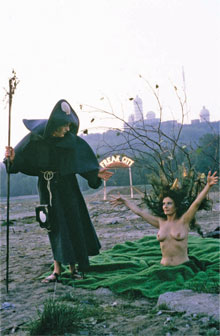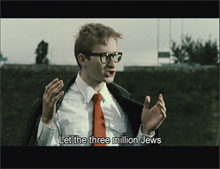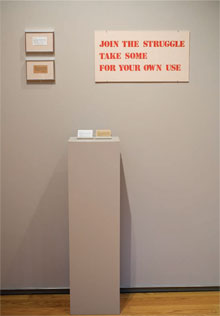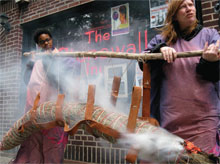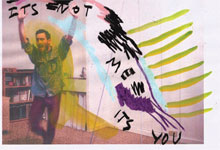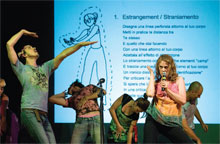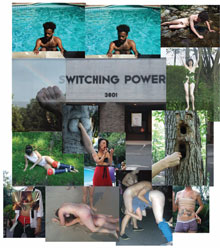Yael Bartana
The project is inspired by several years of witnessing and participating in projects that re-imagine what political protest looks like. And what it feels like. With one foot in the queer and feminist archives, and another in my lived experience of collectivity,i I first began to use the phrase as a way to think through all the reverberations and implications of the work I saw around me—work I was both invested in and identified with. Ecstatic Resistance became the form of my engagement, as both provocation and inspiration, challenge and context. As an artist, it is very important to me to engage my peers’ practices and to think publicly about the terms and contexts of aesthetic production; to develop concepts and experiences from the social and aesthetic fields in which I have had the privilege to situate my life. I was moved to articulate the connections I saw developing and to make explicit a vocabulary with which these artists and their works could make an impact on multiple disciplines. I also believe it crucial to situate these works within a genealogy of activity to assert the trans-historical-ness of the subjects, events, and strategies that are expounded here. Ecstatic Resistance is a thread of historical action that if seized upon has great potential to dismantle and restructure the cultural imaginary. My project here is to write the echoes of ecstatic resistance, a vocabulary with which we can begin a conversation and hope that the related theses set the stage for future actions and articulations. In teasing out the ambitions and potential of the diverse works that inspired this project, I climbed my way through questions of occupation, universality, the unconscious, truth, technology, risk, ethics, and more. Eventually I centralized my understanding and my desire around a few key terms: impossible, imaginary, pleasure, plasticity, strategy, and communicability; connecting these ideas to talk about the image of resistance. Ecstatic Resistance expresses a determination to undo the limits of what is possible to be. I am looking for the body, my body, which exists outside its patriarchal Ecstatic Resistance develops a positionality of the impossible as a viable and creative subjectivity that inverts the vernacular of power. By exposing past impossibilities, the actor of history is thus revealed as the outcast of the contemporary. Ecstatic Resistance works to change this by celebrating the impossible as lived experience and the place from which our best will come. Alongside the vitalization of the impossible life, Ecstatic Resistance asserts the impossible as a model for the political. Politics is a system of that which is forbidden and cannot be done. When politics is framed as ‘reason and progress’ it disguises the primacy of oppression. Changing the perspective of politics away from a positivity and pointing to its limitations and selective applications reorganizes the hierarchy of political actors. The impossible always arrives. It is always the first time. The written, the imagined, the confrontation with reality. Must imagination shun reality, or do the two love each other? Can they become allies? Do they change when they meet? Do they swap roles? It’s always the first time. Lady Windermere in Johanna d’Arc of Mongolia – Ulrike Ottingeriii Ecstatic Resistance postulates the necessity of a new imaginary. The potential of this new imaginary is to move forward from a place that is unrestricted by patriarchal rationality and historical oppositions that serve only the man who is a man and looks like a man and wants to be a man. Great feminist thinkers have long written the desire to unbound sexual difference in the imaginary, to overthrow the rule which creates the world in which the woman is a defective man.iv A world in which the idea of a different body is unspeakable within a system of meaning and recognition. Within this limited frame people have continuously composed their bodies in opposition—living, moving, struggling and improvising meaning. The persistence of these multi-valiant subjectivities has produced many things over time, but it is no longer possible to move forward without amending the imaginary harbored in our bodies and the language that comes forth from there. In order to develop this new imaginary we must be willing to disrupt our knowledge of self, and to risk unrecognizability. This new imaginary is the recently returned phantom left hand of the impossible. It is our body map changing and reconnecting our idea of self to that which was considered impossible—to feel things that can’t be seen, to believe in a body outside the limits of the intelligible. Health consists in having the same diseases as one’s neighbors. –Quentin Crispv Ecstatic Resistance asserts the centrality of plasticity—profoundly acknowledging the ability of brain, body, and culture to reorganize itself. Plasticity is the subterranean quake to the caked shell of modernity. It’s the cross-dressing, cell splitting, boundary shifting, apology giving, friend making mirror. Getting ready for an evening when the plasticity principle pushes up on the pleasure principle and says, “Think again. Think again. Your mind has changed as quickly as the clock. The world is not pleasure, pain, and gratification: we breathe struggle, improvisation and collaboration.” Writing is precisely the very possibility of change, the space that can serve Ecstatic Resistance fundamentally alters the image and process of the political by developing strategies that bypass and subvert entrenched theoretical constructions that set the limits of the intelligible. Ecstatic strategies unearth the potential to find new ways of being in the world. Working to renegotiate the vernacular of power and resistance, the limits of representation become scenes of improvisation in which the process of consolidation and the fallacy of transparency give way to the lived experience of contradiction and simultaneity. Implicit is a critique of representation; explicit is the demand to recognize these strategies as significant contributions to the field of aesthetics and social change. It wasn’t a question of communication or something to be understood, but Ecstatic Resistance emphasizes “the telling” as a key relational model between the unspeakable and communicability. Communicability is defined by the laws of legitimacy–what is possible to say. The unspeakable exists outside of articulation, law, the imaginary and even alterity. “The telling” theoretically triangulates these terms in the form of an encounter. Significant is the formulation of speaking as a desire, a desire to share, to articulate an experience to an/other. The telling springs forth from desire, the tension between pleasure and need forges a route to bridge the encounter. Assisted by affect, the situation becomes improvisational—‘I must find a way’: to say what I mean, to share what I’ve seen. “The telling” occupies a space between reportage and the creative function of self-narrativizing. The act of sharing inaugurates the potential of one experience to accumulate and become a formative moment of transformation. Ecstatic Resistance is an inquiry into the temporality of change. Time, the time of transformation, the duration and physicality of the experience of change. And drama—the arc of history. The temporality of the ecstatic opens a non-linear experience in which connections are made at break neck pace and a moment later time appears to stop us in the dynamism of one challenging thought. This disorganization of time is against the force of realism. It is a personal allowance that once incorporated proliferates the production of alternatives and builds new perspectives from the ruins. Excesses of experience become the fragments for the future. Ecstatic Resistance wonders about waiting—the dynamic between action and recognition, movement and the symbolic. This exhibition attempts to bring together projects that present a diverse slice of ecstatic resistance–conceptually, aesthetically, and generationally. The exhibition wrestles the question of ‘what is possible’ into a new arena in which the cultural symbolic is dislodged long enough that the excess of its formulations tumble back into play. Some works create a place from which to build ethical structures for the impossible to thrive. While others accentuate the lived experience of impossibility and resistance. They speak pleasure to power. They shake their sensuous amputated left hand at the invisible naysayer and say, “Why not?” The show presents experiments in Ecstatic Resistance. The strategies are manifold: My Barbarian perverts traditional structures used in the dissemination of ‘common sense.’ Adrian Piper writes a provocation into definition defying space. Yael Bartana makes room for the political impossible. Jeanine Oleson orchestrates a clash between nature, culture, humor and power. Sharon Hayes connects desire and articulation as political necessity. Ian White performs the constraints of being free. Ulrike Ottinger creates intricate journeys of excessive realities. A.L. Steiner refuses the logic of the phallocentric world order. Matthew Lutz-Kinoy dances an ecstatic encounter and all its reverberations. Dean Spade and Craig Willse suspend us in the question of now, when or then did the revolution give us everything we asked? What is it possible to think within the installation that before you approached it you cannot have imagined? Emily Roysdon September 2009 Notes iii Ulrike Ottinger, Image Archive, Verlag für moderne Kunst, Nürnberg, 2005, p.11. iv Notably Hélène Cixous and Luce Irigaray. v Quentin Crisp, The Naked Civil Servant, 1975, transcribed from film. vi Hélène Cixous, The Laugh of the Medusa, trans. Keith Cohen and Paula Cohen, Signs 1, no. 4 (1976): 875-93. vii John Cage, transcribed from radio interview, WNYC, August 27, 2007, http://www.wnyc.org/music/johncage.html.
Emily Roysdon and Grand Arts would like to thank the following institutions for their loans and generous assistance with the exhibition: The Davis Museum of Art and Cultural Center at Wellesley College (Wellesley, MA), The Adrian Piper Research Archives (Berlin), Ulrike Ottinger Filmproduktion (Berlin), and Annet Gelink Gallery (Amsterdam).
|
|

